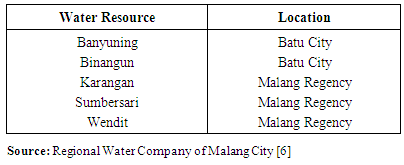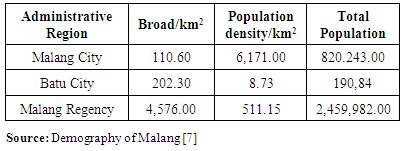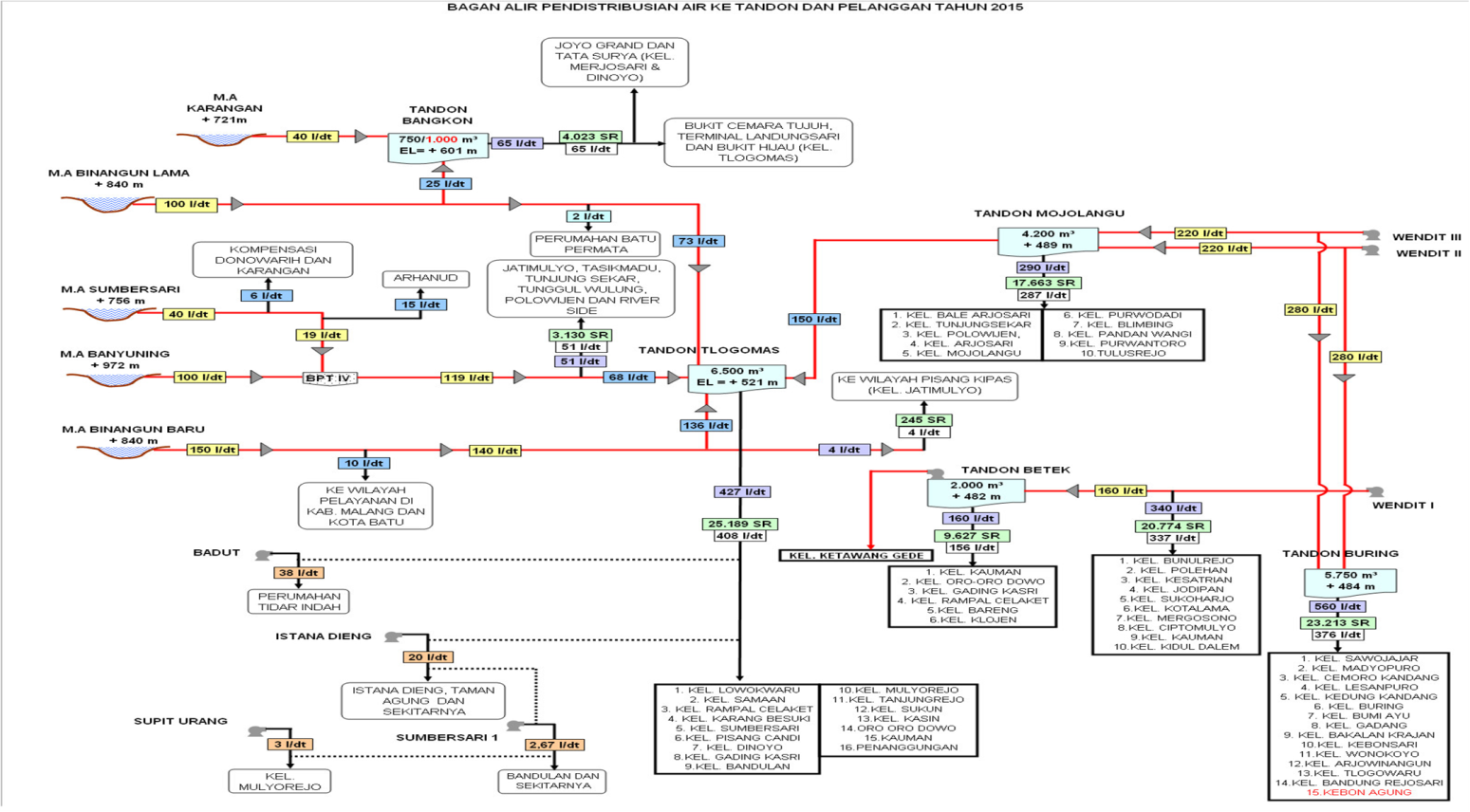-
Paper Information
- Paper Submission
-
Journal Information
- About This Journal
- Editorial Board
- Current Issue
- Archive
- Author Guidelines
- Contact Us
International Journal of Applied Sociology
p-ISSN: 2169-9704 e-ISSN: 2169-9739
2015; 5(2): 106-112
doi:10.5923/j.ijas.20150502.06
Regional Intergovernmental Cooperation Model in Water Resources Management in the Era of Regional Autonomy (Case Studies on City Government of Malang and Batu, and Regency Government of Malang, East Java, Indonesia)
Haeruddin1, Agus Suryono2, M. R. Khairul Muluk2, Tjahjanulin Domai2
1Doctoral Program of Administrative Studies, Faculty of Administrative Sciences, University of Brawijaya, Malang, Indonesia
2Faculty of Administrative Sciences, University of Brawijaya, Malang, Indonesia
Correspondence to: Haeruddin, Doctoral Program of Administrative Studies, Faculty of Administrative Sciences, University of Brawijaya, Malang, Indonesia.
| Email: |  |
Copyright © 2015 Scientific & Academic Publishing. All Rights Reserved.
The regional administration in the context of regional autonomy brought significant changes to the centralization system of local governance turned into a decentralized system. This normative phenomenon is creating administrative boundaries and functional area for each local government as an autonomous region. While empirical phenomena in the administration of public services across the region hindered administrative problems and functional boundaries of each local government, as a solution to overcome these problems required cooperation among local governments. Researchers adopting the concept of cooperation between local government approach (Smith) consisting of; 1). Legal and political approaches; 2). Inter-Organizational Politics; and 3). Political Community, to be used as a tool dialogue and analysis of the research findings. This study used a qualitative approach to research instruments; people, events and documents. Data collection techniques are interview, observation and documentation. Data analysis techniques are grounded theory. Our study focus on: 1). The processed for determining the object of cooperation; 2). Implementation of cooperation in water resources management; 3). Factors that influence the management of water resources. The results showed that 1). The process of determining the object of cooperation has met the principles of law and administration, reduce regional ego; 2). Implementation of the cooperation is not only a formality but prefers the value of togetherness, efficiency and effectiveness of service provision for drinking water has been established well characterized by the distribution of drinking water services in the three local government in Malang; 3). The most influential factor is the regional head support, coordination and less harmonized local ego; 4). Cooperation model that built up is joint service agreement in written agreements and intergovernmental agreement model (government to government = G to G).
Keywords: Intergovernmental cooperation, Local government, Autonomy, Water resources and water supply systems
Cite this paper: Haeruddin, Agus Suryono, M. R. Khairul Muluk, Tjahjanulin Domai, Regional Intergovernmental Cooperation Model in Water Resources Management in the Era of Regional Autonomy (Case Studies on City Government of Malang and Batu, and Regency Government of Malang, East Java, Indonesia), International Journal of Applied Sociology, Vol. 5 No. 2, 2015, pp. 106-112. doi: 10.5923/j.ijas.20150502.06.
Article Outline
1. Introduction
- The concept of regional autonomy as a manifestation of the decentralization principle in governance is actually an application from theoretical concepts "areal division of power" that divides power vertically [1]. The substance in the regional autonomy implementation of local government mandates efficiently and effectively, improving intergovernmental relations in the discharge of public service, and decision-making becomes more close to the community it serves. Interval control of the government become closer, more responsive to local needs; improve the allocation or distribution of productive resources through the shifting role of public decision making to the lowest level of government [2].Implementation of local government system in the context of regional autonomy brought significant changes to the system of local governance; i.e. the centralized system turned into a decentralized system. This normative phenomenon is creating administrative and functional boundaries for each local government as an autonomous region. Otherwise, empirical phenomena in the administration of public services across the region hindered administrative problems and functional boundaries of each local government that can lead to conflicts of interest. As a solution to overcome these problems, it required cooperation among local governments.The phenomenon of cross-regional issues of administrative and functional boundaries can be solved together and potential resources at their disposal area can be utilized for the mutual benefit through cooperation between local governments [3]. It also confirmed by Ramses [4] that cooperation among autonomous region has become a basic need and urge to run well, in order to optimize the regional administration in carrying out the functions of public service, community empowerment and local economic development.While based on the Law of Republic of Indonesia No. 32 of 2004 on local government, Article 195 [5] has mandated:(1) in order to improve the welfare of the people, the area can be entered into a collaboration with other areas which are based on considerations of efficiency and effectiveness of public services, synergy and mutual benefit; (2) cooperation referred to in paragraph 1 (a) can be realized in the form of inter-regional cooperation bodies governed by the joint decision; (3) in the provision of public services, the region can cooperate with third parties; (4) cooperation referred to in paragraph 1 (a) and paragraph 3 (three) are a burden on society and the area must be approved by the regional representatives.The substance of the regulation above indicates that one of the goals of cooperation among local governments is to improve the welfare of the community through public service. To that end, the Government of Malang City, Batu City and Malang Regency conducted cooperation on water resource management for the implementation of water supply systems in Malang. The reality shows that Malang government in terms of geographical location and natural conditions were shortage for water resources to meet the needs of raw water to be proceeded into drinking water. This condition makes the government of Malang supply water resources from Malang Regency and Batu City. The location of the water resources is available in Table 1.
|
2. Research Methods
2.1. Study Object
- The overall area of Malang which consists of Malang City, Malang Regency and Batu City are 4,888.36 km2, with an average population density 707.11/km2 of the total population of 3,456.645 (Table 2). The amount and distribution of the population as well as the issue of the availability of water resources in each local government ownership on the volume of water resources is different; each addressed by local government to conduct joint use of water resources for the provision of water supply system in Malang [7].
|
2.2. The Research Approach
- This study used a qualitative approach of Strauss and Corbin [9], which suggests for the purpose of finding, understanding the descriptions and gets the problem clearly. We choose qualitative research to assess the phenomenon logically and reveal something behind the phenomena and noumena [10]. The research instruments are people, events and documents. Data collection technique is interview, forum group discussion (FGD), observation and documentation study [11].
2.3. Research Focus
- The focus of the study includes: 1. The approach on determining the object which cooperated include: administrative approach; inter-institutional and political approach; social policy approach [12]. 2. Implementation of the agreement including: Wendit, Sumbersari and Karangan cooperated intergovernmental between Malang City and Malang Regency; Banyuning and Binangun between Malang City and Batu City Government; Cinde and Dandang between Batu City and Malang Regency Government.3. Factors that influence the process and implementation of water resources management cooperation between the Government of Malang City, Batu City and Malang Regency are: 1). Support from Regional Head; 2). Potential and Limitations of Water Resources (similar interests, coordination and regional ego).4. Model of cooperation that has been built.
2.4. Data Processing
- Data analysis techniques are grounded theory based on the sequenced data analysis. Strauss and Corbin [13] stated that the analysis of data in grounded theory also called coding, which actually goes systematically and continuously performed data collection. The phases of analysis include: 1). Open Coding; specifically perform the naming and create categories on the phenomenon by studying the data closely. 2). Axial Coding; reunite the data in a different way to find relationship between a category with sub-categories. 3). Selective Coding; a systematic examination of categories related to other categories.
3. Result and Discussion
3.1. Approach Process on Object Determination of Cooperated Water Resources
- Research findings showed dominance in the decision making process of determining cooperated water resources object between the Government of Malang City, Batu City and Malang Regency (Table 3):
|
3.2. Factors Influencing the Cooperation of Water Resources Utilization between Malang City, Batu City and Malang Regency
- The factors that affect both the process and the implementation of the cooperation between the Government of Malang City, Batu City and Malang Regency described in Tables 4. Factors that affect the cooperation are the support of local leadership, potential and limitations of local water resources; including sub-factor of common interest, coordination and regional ego. These factors become the deciding factor for the successful of the cooperation on the utilization of water resources between Government of Malang City, Batu City and Malang Regency.
|
3.3. Existed Model of Intergovernmental Cooperation
3.3.1. Model of Administrative and Institutional Processes
- Cooperation model that is developed through the process of administrative and institutional similar to the concept model of intergovernmental transfer service. The results showed that there was a transfer of authority and object management responsibility [20] for water resources cooperation between the Government of Malang City, Batu City and Malang Regency.
3.3.2. Model of Political Processes
- Established model of cooperation is between local governments and other local government (G to G); the main feature of the old perspective on public administration. Research findings indicate that the cooperation made in written agreements and vis-to-vis [21] between the Government of Malang City, Batu City and Malang Regency.
3.3.3. Model of Planning Processes
- Planning model that existed indicates the involvement of all stakeholders of water resources. The stakeholders have the same interests and interdependencies [22] in the planning process and implementation of the cooperation between the Government of Malang City, Batu City and Malang Regency.
3.3.4. Model of Evaluation and Supervision
- Model of evaluation and supervision that has been established is an independent model. However, the findings showed constraint that requires special attention; such constraint related to disintegrated organization structure. Existing structure is a partial structure that is based on the interests of each local government [23].
4. Conclusions
- The determining process of the water resources object through cooperation and administrative law approach refer to the formal legality of the agreement. This process dominates the decision-making process. For inter-institutional political approach, top-down principle refers in the process of making an agreement. Because the object of water resources cooperation were dominates by the respective roles of regional heads. While the normative social political approach is bottom-up; the decision-making process prioritizes the active participation of the community but in the process of determining the object of cooperated water resources, less public positions taken into account.Cooperation between the Government of Malang City, Batu City and Malang Regency has been implemented efficient and effectively, resulting a positive benefit to the three local governments. For example: operation of the water system in a holistic manner, received the value of the contribution/compensation and retribution as a source of revenue for each local government.Support of Regional Head is the most influential factor for the respective heads of regions to be involved simultaneously in the cooperation agreement. Potential and limitations of water resources include: common interest, coordination and ego area, also quite influential in the process and the implementation of cooperation.Established model of cooperation through administrative processes and institutions is a joint service agreement in written agreements. The cooperation arrangement is based on a written agreement with the support of the political will of each head area.The model of cooperation that is developed through the planning process is: 1) agent model, local governments implement policies of the central government under the supervision of representatives from the central government. 2) The partnership model, each local government has the same position and freedom to design and implement policies.The model of cooperation that is developed through the process of evaluation and supervision is: 1) Model of Intergovernmental Agreements. The model involves G to G cooperation. 2) Model of contracts, which involve elements of government and various stakeholders.
5. Recommendations
- Cooperation between the Government of Malang City, Batu City and Malang Regency in the utilization of water resources, should establish a joint secretariat of the organizing committee to create networks. It is also to improve efficiency and effectiveness of the management of cooperation programs that have been agreed upon.For each process and the implementation of cooperation among local governments can guarantee the social, economics and politics justice for all three local governments, it should consider the use of a zoning approach to the scope of services based on the characteristics of each area. Local government cooperation should give priority to the principle of harmony of interests related to the scope of each object that cooperated, and should have a strong commitment to fulfilling the rights and obligations of any object cooperation.
Supplementary 1. Water Distribution in Malang Raya Area
Supplementary 2. Recommendation Model of Water Resources Cooperation

 Abstract
Abstract Reference
Reference Full-Text PDF
Full-Text PDF Full-text HTML
Full-text HTML



